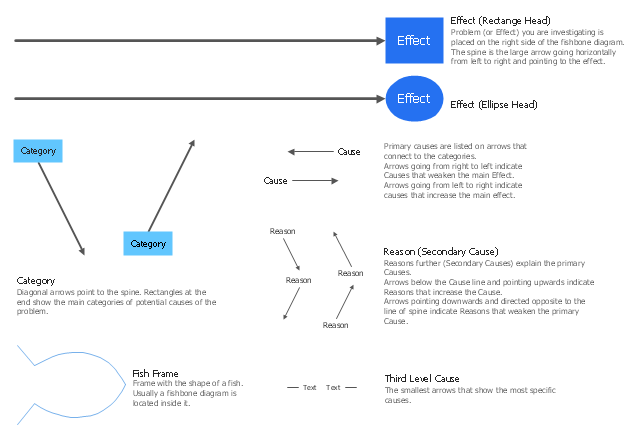The library of vector stencils "Fishbone diagrams" contains 13 symbols for drawing the Ishikawa diagrams using the ConceptDraw PRO diagramming and vector drawing software.
"Ishikawa diagrams were popularized by Kaoru Ishikawa in the 1960s, who pioneered quality management processes in the Kawasaki shipyards, and in the process became one of the founding fathers of modern management.
The basic concept was first used in the 1920s, and is considered one of the seven basic tools of quality control. It is known as a fishbone diagram because of its shape, similar to the side view of a fish skeleton." [Ishikawa diagram. Wikipedia]
"The Seven Basic Tools of Quality is a designation given to a fixed set of graphical techniques identified as being most helpful in troubleshooting issues related to quality. They are called basic because they are suitable for people with little formal training in statistics and because they can be used to solve the vast majority of quality-related issues.
The seven tools are:
(1) Cause-and-effect diagram (also known as the "fishbone" or Ishikawa diagram);
(2) Check sheet;
(3) Control chart;
(4) Histogram;
(5) Pareto chart;
(6) Scatter diagram;
(7) Stratification (alternately, flow chart or run chart)." [Seven Basic Tools of Quality. Wikipedia]
The example "Design elements - Fishbone diagram" is included in the Fishbone Diagrams solution from the Management area of ConceptDraw Solution Park.
"Ishikawa diagrams were popularized by Kaoru Ishikawa in the 1960s, who pioneered quality management processes in the Kawasaki shipyards, and in the process became one of the founding fathers of modern management.
The basic concept was first used in the 1920s, and is considered one of the seven basic tools of quality control. It is known as a fishbone diagram because of its shape, similar to the side view of a fish skeleton." [Ishikawa diagram. Wikipedia]
"The Seven Basic Tools of Quality is a designation given to a fixed set of graphical techniques identified as being most helpful in troubleshooting issues related to quality. They are called basic because they are suitable for people with little formal training in statistics and because they can be used to solve the vast majority of quality-related issues.
The seven tools are:
(1) Cause-and-effect diagram (also known as the "fishbone" or Ishikawa diagram);
(2) Check sheet;
(3) Control chart;
(4) Histogram;
(5) Pareto chart;
(6) Scatter diagram;
(7) Stratification (alternately, flow chart or run chart)." [Seven Basic Tools of Quality. Wikipedia]
The example "Design elements - Fishbone diagram" is included in the Fishbone Diagrams solution from the Management area of ConceptDraw Solution Park.
- Stratification Run Chart Tool Of Quality
- Seven Basic Tools of Quality - Quality Control | Seven Basic Tools of ...
- Stratification diagram example
- Seven Basic Tools of Quality - Quality Control
- Design elements - Stratification diagram | Stratification diagram ...
- GPRS network diagram | Total Quality Management Value | Work ...
- Pyramid Diagram | Total Quality Management Value | TQM Diagram ...
- Total Quality Management Value | Seven Basic Tools of Quality ...
- Stratification diagram example | Basic Diagramming | Line Chart ...
- Design elements - Fishbone diagram | Flowchart Definition | Draw ...
- Design elements - Fishbone diagram | Fishbone diagram - Template ...
- Pict Tool Example
- Total Quality Management Value | Successful Strategic Plan ...
- Multi Layer Venn Diagram. Venn Diagram Example | Management ...
- Design elements - Run chart | Nursing department finance | Nursing ...
- Design elements - Fishbone diagram | Total Quality Management ...
- Design elements - Fishbone diagram | Fishbone Diagram | Cause ...
- 7 Tools For Quality Example
- Pyramid Diagrams | Pyramid Diagram | How to Draw a Pyramid ...
- Seven Management and Planning Tools | Process Flowchart | Total ...
